Radon Transport Mechanism in Soil may Predict Earthquake Reveals NIT Rourkela Researcher
Rourkela: Radon transport mechanism in the soil can predict earthquake says the researcher of the National Institute of Technology Rourkela. In this regard, Professor of Mathematics at NITR, Dr. Snehashish Chakraverty and his team members are working on this challenging problem from the last four years by combining the concept of interval uncertainties. ‘’By this modeling, one may estimate a general uncertainty band of radon concentration in the earth crust. By observing the anomaly behavior of the band of the radon data generated may lead to the prediction of earthquake and tsunami. For the practical applicability of the model, they used the radon data generated from a Geo-station installed at NIT Rourkela. This is funded by BRNS (Board of Research in Nuclear Sciences), Dept. of Atomic Energy, Mumbai’’ says Professor Chakraverty.
Radon is a naturally occurring radioactive noble gas emanating from the soil, rocks, building materials etc. In the last decade, several studies have concluded that elevated concentrations of radon gas in soil or groundwater could be the sign of an imminent earthquake. It is believed that there is a drastic change in radon concentration released from cavities and cracks due to anomaly effects like earthquake, tsunami etc. In this regard, mathematical modeling of radon transport in the earth crust may be a useful tool to investigate changes in the geophysical processes prior to earthquake event. However, in order to determine the magnitudes of parameters governing these processes from experimental measurements, it is necessary to investigate the role of uncertainties in these parameters. In view of this, the correct interpretation of real-time monitored data of Radon and its correlation with seismic events requires a better understanding of the radon transport process in soil pore and its perturbation during earthquake events. So, handling radon transport equation to predict the anomaly behavior of radon gas with uncertain parameters is a challenging task.
Professor Chakraverty’s team include Ph. D. students Tharasi Dilleswar Rao and Karunakar Perumandla in collaboration with BARC (Bhabha Atomic Research Center, Mumbai, India) scientists Dr. Bijay Kumar Sahoo and Dr. B.K. Sapra. This work has recently been published in the Journal of Environmental Radioactivity.

